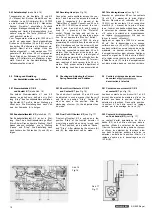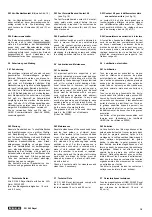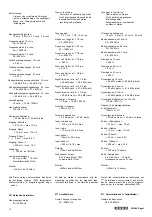
Der die Bandspule aufnehmende Spulenteller
ist fest mit einer Kupplungsscheibe verbun-
den, die an ihrer Unterseite mit einem Filz-
belag versehen ist. Gegen diese filzbelegte
Kupplungsscheibe wird eine Druckscheibe
stärker oder schwächer angedrückt. Dadurch
wird das Mitnahmemoment der aufwickeln-
den Kupplung bestimmt. Die horizontale Be-
wegung des Fühlhebels wird umgesetzt in
einen vertikalen Druck auf die Druckscheibe.
Der Fühlhebel ändert seine Stellung mit dem
Bandwickeldurchmesser.
Im folgenden wird erklärt, wie der Bandzug
entsteht und geregelt wird.
Der Bandzug entsteht durch die Reibung der
beiden Kupplungsteile (Kupplungsscheibe
und Druckscheibe) gegeneinander. Die Größe
des Bandzuges wird durch Vorspannen der
Komparatorfeder eingestellt. Die Kompara-
torfeder greift an dem Fühlhebel an. Ihre
Zugkraft ist der Kraft des Abwickel- bzw.
Aufwickelzuges entgegengesetzt gerichtet.
Die Geichmäßigkeit des Bandzuges über die
gesamte Bandlänge wird durch die Regelung
des Mitnahmemomentes der Kupplungen
erzielt.
Nachfolgend wird das Zusammenwirken von
Bandzugkomparator und Laufwerk bei den
Betriebsarten „Pause", „Start", „Vorlauf"
und „Rücklauf" dargestellt und erläutert.
The turntable, which receives the tape reel, is
rigidly connected with a clutch disk which,
in turn, has a felt lining on its bottom side.
A thrust disk is pressed against this felt-
lined clutch disk with varying force.
This force determines the torque of the take-
up clutch. The horizontal movement of the
sensing lever is transformed into vertical
thrust against the thrust disk. The sensing
lever will alter its position in accordance with
the diameter of the tape roll.
Origin and control of the tape tension are
discussed below.
The tape tension originates due to the fric-
tion between the clutch disk and the thrust
disk. The amount of tape tension is adjusted
by pretensioning the corresponding compa-
rator spring. The comparator spring is linked
to the sensing lever. The force produced by
the comparator spring opposes the force
exerted by the pay-out tape tension or take-
up tape tension respectively. A constant tape
tension along the entire length of the tape
is adjusted by controlling the torque of the
clutches.
The combined operation of the tape tension
comparator and the other parts of the trans-
port mechanism in the modes "Pause",
"Start", "Fast Forward" and "Rewind" is
now described and explained in detail.
Le plateau qui supporte la bobine de la
bande magnétique est solidaire d'un disque
d'embrayage, dont la face inférieure est
garnie d'une rondelle de feutre. Un plateau
presseur qui s'appuie plus ou moins forte-
ment sur cette face détermine le couple
d'entraînement de l'embrayage enrouleur. Le
mouvement horizontal du levier palpeur est
converti en un effort vertical sur le plateau
presseur. En outre, le levier palpeur modifie
sa position en fonction du «diamètre de bo-
binage» de la bande, c'est-à-dire en fonc-
tion de la longueur de bande encore dis-
ponible sur la bobine.
La traction exercée sur la bande résulte de
l'effort de friction entre le disque d'embraya-
ge et le plateau presseur. L'effort de trac-
tion dépend de la tension d'un ressort qui
agit sur le levier palpeur, à savoir à
contre de l'effort de déroulement ou d'en-
roulement. La régularité du défilement sur
toute la longueur de la bande s'obtient par
la stabilisation du couple d'entrainement
des embrayages.
L'interaction du comparateur de bande et du
mécanisme d'entrainement est expliquée et
représentée ci-dessous en régime
«Start», «Défilement accéléré avant» et «Dé-
filement accéléré arrière».
1.11 Pause (siehe Abb. 1)
Die auf der Achse des Hysteresis-Synchron-
Motors sitzende Motorrolle (A) ist entspre-
chend den vier Bandgeschwindigkeiten abge-
stuft und treibt über das Reibrad (B) die
Schwungmasse (C) und damit die Tonwelle
an.
Der von der Motorrolle (A) getriebene Rie-
men (D) bewegt das linke Friktionsrad (E),
das Antriebsrad (F) und die Druckscheibe (G)
der aufwickelnden Kupplung.
Die Bremse (P) wird von der Druckscheibe
(G) abgehoben. Die Druckscheibe (G) kann
sich ungehindert drehen. Die anliegende
Bremse (Q) sperrt die Druckscheibe (O).
Von einer Mechanik, welche den rechten
Fühlhebel nach links drückt, wird das Mit-
nahmemoment der Aufwickelkupplung be-
stimmt.
Pause (see Fig. 1)
The motor pulley (A) fitted to the spindle of
the motor is stepped in relation to the four
tape speeds and drives the flywheel (C) via
the friction wheel (B) and thus also the
capstan.
The motor pulley (A) drives the belt (D),
which in turn drives the left-hand friction
wheel (E), the drive wheel (F) and the thrust
disk (G) of the take up clutch.
The brake (P) is lifted from the thrust disk (G).
The thrust disk (G) can now rotate freely.
The applied brake (0) blocks the thrust
disk
The driving moment of the winding-on clutch
is determined by a mechanical unit, which
presses the right-hand sensing lever to the
left.
1.11 Pause (voir fig. 1)
La poulie (A) assise sur l'axe du moteur syn-
chrone à hystérésis comporte quatre vitesses
de défilement. Elle entraine le volant (C) par
l'intermédiaire de la roue à friction (B) et par
conséquent le cabestan. La courroie (D) en-
traînée par la poulie (A) du moteur transmet
son mouvement à la roue à friction gauche
(E), à la roue d'entrainement (F) et au plateau
presseur (G) de l'embrayage enrouleur.
Le frein (P) se détache du plateau presseur
(G) qui peut alors tourner librement. Le frein
(Q) reste par contre appliqué sur le plateau
presseur (O) et le bloque.
Un système mécanique qui repousse vers la
gauche le levier palpeur droit, détermine le
couple d'entrainement de l'embrayage en-
rouleur.
1.12 Start (siehe Abb. 1)
In Stellung „Start" wird das Band mittels der
Andruckrolle an die Tonwelle gedrückt und
transportiert.
Zugleich beginnen die Fühlhebel (H) und (I)
und die Komparatorfedern (K) und (L) zu ar-
beiten. Die horizontale Bewegung der Fühl-
hebel (H) und (I) wird mittels der Winkel-
hebel (M) und (N) auf die Druckscheiben (G)
und (O) übertragen. Abhängig vom Band-
wickeldurchmesser der beiden Spulen halten
die Fühlhebel den Bandzug konstant.
1.12 Start (see Fig. 1)
In position "Start" the tape is pressed against
the capstan with the aid of the pressure rol-
ler and is transported.
At the same time the sensing levers (H) and
(I) and the comparator springs (K) and (L)
begin to work. The horizontal movements of
the sensing levers (H) and (I) are transmitted
to the thrust disks (G) and (O) respectively
by means of the angular thrust levers (M)
and (N). As a function of the diameters of
the two tape reels, the sensing levers keep
the tape tension constant.
1.12 Start (voir fig. 1)
En
la bande magnétique est
appliquée par le galet presseur contre le
cabestan et transportée.
En même temps, les leviers palpeurs (H) et
(I) ainsi que les ressorts (K) et (L) du com-
parateur entrent en action. Le mouvement
horizontal des leviers palpeurs (H) et (I) est
transmis par les leviers coudés (N) et (M)
sur les plateaux presseurs (G) et (O). L'effort
de traction est stabilisé par l'intermédiaire
des leviers palpeurs et dosé en fonction de
la longueur de bande enroulée sur les deux
bobines.
SG 560 Royal






















